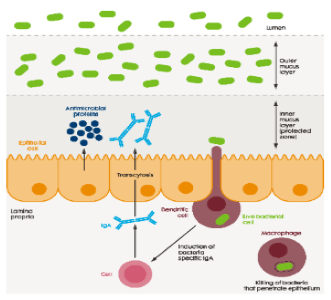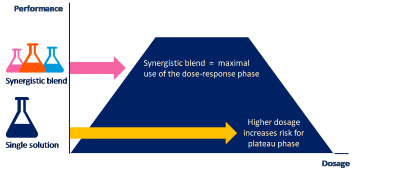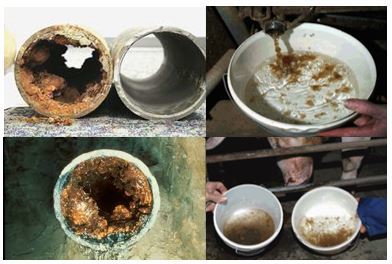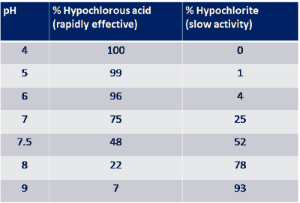Management of Poultry Feed and Water Hygiene
In today’s scenario of intensive poultry farming, the birds are exposed to various stressors during its production cycle to reap the genetic potential of the bird to the maximum extent possible. Under these situations bird’s gut health can be compromised to a large extent if not taken care of. Healthy gut comprises of a diverse and well-balanced microbiota, good gut wall integrity (as shown in Fig. 1) and immunity which all heavily influence the digestive efficacy of the gut and the subsequent bird’s overall production efficiency. The various factors that can influence the gut health are hygiene of feed, water, environment, hatchery, vertical transmission, disease carriers and vectors etc. Of these, the factors that are well within the control of poultry producers are hygiene of feed and water.
Fig 1: Integrity of gut

I. Feed Hygiene Management:
Feed, as usual, stays to be the highest contributor for poultry production costs to the tune of 70-75%. With sky rocketing prices of maize, this number should be somewhere around 80% in the current situation. A well-defined strategic approach needs to be designed and followed with respect to quality control of feed.
a. Raw material quality control
Stringent quality control measures should be in place with respect to acceptance of raw materials received at the feed mill. With South-West monsoon striking in, the raw material moisture is ought to go up either due to the high moisture possibility at harvest or during transit of the raw materials. The raw material moisture seen nowadays is in the tune of 14-18%. High moisture content can pose problems of fungal contamination and further production of mycotoxins in grains and bacterial and fungal contamination in protein sources. Quicker and reliable analytical technologies/methods need to be followed for having a detailed nutrient and toxin profile of the raw material in receipt.
b. Raw material storage
A good raw material can turn out to be a not so good one, if not stored effectively. Optimal storage is very much critical, more so true, when the raw material moisture is on the higher end. Sufficient care should be taken with respect to apt ventilation in the storage area, use of wooden pallets, spacing between the bags and the bags from the wall, stacking of bags etc.
If the raw materials are not stored properly, specifically the grains with high moisture, it may lead to fungal growth with eventual production of mycotoxins (aflatoxins and ochratoxins – storage mycotoxins). The inventory of raw materials with high fat content like rice polish, full fat soya, corn gluten meal should not be more than 15 days, owing to the rancidity of fat. The oil tanks/cans/containers once opened should be added with an effective antioxidant to prevent oxidation, during storage.
In addition, with respect to storage of raw materials in silo, if sufficient steps not taken, silo can turn as a bane rather than a boon – spoiling the quality of huge lot of raw materials that are stored within it. There should be sufficient airflow maintained within the silos, to prevent excessive heat buildup with associated fungal sporulation and growth.
c. Feed mill management
Routine feed mill audits have to be carried out as an approach to improve feed mill efficiency. All the machinery of feed mill should be flushed with a good acidifier as a part of feed mill hygiene program, to take care of any fungal/bacterial contamination that would have occurred in the machinery.
d. Usage of feed additive concepts
Organic acid concepts when used in a proper way are proven to work effectively in management of feed hygiene. Various concepts have been used for prevention of mold, bacteria etc. in feed. Certain organic acid combinations work to improve the gut health of poultry that might have been affected due to poor feed hygiene – due to its poor management at farm/feed mill. The type of organic acids, the form in which it is included, their pKa, stability etc. play a crucial role in determining the efficacy of organic acid concept. It is always judicious to use a blend of organic acids than a single organic acid, to have synergistic and broad spectrum action, as shown in Fig. 2.
Fig 2: Benefits of synergistic organic acids blend over single organic acid

e. Feed storage and logistics
Measures similar to that adopted for raw material storage need to be followed for storage of feed at feed mill as well. Similarly, it is always better if the feed is transferred to farms in clean trucks and with transit time of not more than 2 to 3 days, to avoid probable microbial exposure and harsh external environmental conditions, respectively.
f. Feed management at farm
Fresh feed should always be provided to birds. Similarly, the feeder should be cleaned on a daily basis to prevent microbial growth. The feeder height should be optimal to prevent contamination of feed with fecal matter. Additionally, feed spillage, needs to be equally avoided with proper feed management practices, which can serve as an invite to the pests and rodents further threatening feed hygiene.
II. Management of Water:
An equally important factor that contributes to maintaining the hygiene of poultry is Water. Poultry producers do not spend much money (as compared to feed) on the water quality that is been offered to poultry. It has been neglected by many. Nevertheless, it is the most critical inputs of poultry production, without which the bird’s feed intake, feed digestion, absorption or any of the metabolic activities would not be taking place inside the bird’s body. The various factors to be considered in the management of water hygiene are as detailed below.
a. Quality control of water:
Water has been to be regularly checked once in three months, and when there is a change in season, in an authenticated laboratory for pH, hardness, microbiology, TDS, ORP and specific inorganic matter. With the onset of monsoon – the rain, will invariably increase the ground water table content, but it also washes along with it various unwanted sediments/residues of inorganic matter, sewage waste etc. Therefore, in the rainy season, extra care should be taken with respect to enhancing the water quality.
b. Management of pipelines & waterers:
The pipelines need to be flushed adequately between the flocks with a good acidifier to take care of any biofilm that has been developed during the process of flock grow out. Biofilm is conglomeration of bacterial growth, that effectively reduce both the quality and quantity of water that is been offered to birds, as shown in Fig. 3. If not adequately treated, biofilms can produce a dangerous threat with respect to water hygiene, causing microbial contamination of water, which is supposedly been, treated to take care of the microbes (but does not happen so because of the biofilms).
Fig. 3: Biofilms clogging the pipeline

The waterers and canisters should be regularly cleaned and adequate height need to be maintained for waterers, to avoid any external contamination. Fresh water should always be provided to birds. Additionally, the water tanks need to be regularly cleaned as well in weekly or biweekly intervals. They should be covered properly, to avoid any rain water contamination.
c. Inclusion of water additives:
Acidification of water to a pH of 5.5 is necessary, if good water quality is to be guaranteed. Sanitizers will not work efficiently or may not work at all if the water pH is above 6.0. The chlorine based sanitizers will be effective only if the pH of water is acidic as shown in Table 1 below.
Table 1: Correlation between water pH and chlorine

Good quality water and gut acting organic acids need to be added in water, to promote hygiene of water as well gut. The additives/concepts thus included, should be the ones that are capable of providing a stable water quality throughout the day.
III. Role of laboratory
An in-house laboratory is best option for analysis of feed ingredients and water. Otherwise, a third party animal nutrition laboratory that is capable of providing apt and prompt assay results needs to be identified. The right quantity of sample needs to be drawn for physical and chemical analysis. Adequate sampling of ingredients is crucial for mycotoxin analysis, wherein 90% of the errors in toxin assay arise from improper sampling. The sample drawn should be representative of the lot and should be carried out using a proper sampling instrument, and should be collected and sent in a sealable container or zip-lock plastic pouches. For water samples, the water needs to be collected in sterile vials/bottles and should be packed sufficiently (in dry ice if distance is longer), so as to reach the laboratory within 24 hours, if a microbiological analysis is intended. The quality control laboratory should be very quick enough in providing reliable assay results.
Of late, there are various innovative technologies that can be used at the farm level (bringing the lab to the sample rather than other way round), for providing a real-time, rapid and accurate analysis of nutrient profile of feed ingredients and water quality. The poultry producer need to be prudent enough to adopt these technologies for enabling a quicker decision process.
To conclude, the management of feed and water hygiene is very critical in controlling the overall poultry performance. With changing mindset of human consumer, who is now looking for a safe produce (meat/egg), in his plate, and to enable the farm to fork concept, a safe poultry production need to be ensured. This can be possible by adopting the various holistic steps detailed above for maintaining the hygiene of feed and water. The challenges would vary from farm to farm, and hence the solutions need to be customized as per the prevailing conditions.
Trouw Nutrition is committed to assist poultry producers with their range of gut health programs and solutions that are to be included through feed and/or water, according to the need of the customer.
Please get in touch with your local Trouw Nutrition representative or contact us at customercareindia@trouwnutrition.com to know more.